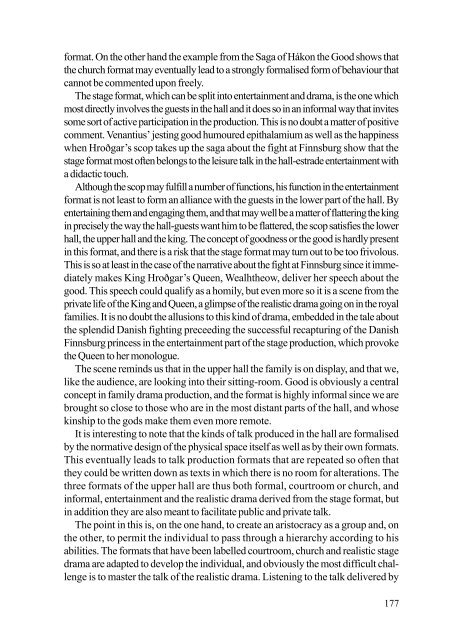Beowulf - Institutionen för arkeologi och antik historia
Beowulf - Institutionen för arkeologi och antik historia
Beowulf - Institutionen för arkeologi och antik historia
You also want an ePaper? Increase the reach of your titles
YUMPU automatically turns print PDFs into web optimized ePapers that Google loves.
format. On the other hand the example from the Saga of Hákon the Good shows that<br />
the church format may eventually lead to a strongly formalised form of behaviour that<br />
cannot be commented upon freely.<br />
The stage format, which can be split into entertainment and drama, is the one which<br />
most directly involves the guests in the hall and it does so in an informal way that invites<br />
some sort of active participation in the production. This is no doubt a matter of positive<br />
comment. Venantius’ jesting good humoured epithalamium as well as the happiness<br />
when Hroðgar’s scop takes up the saga about the fight at Finnsburg show that the<br />
stage format most often belongs to the leisure talk in the hall-estrade entertainment with<br />
a didactic touch.<br />
Although the scop may fulfill a number of functions, his function in the entertainment<br />
format is not least to form an alliance with the guests in the lower part of the hall. By<br />
entertaining them and engaging them, and that may well be a matter of flattering the king<br />
in precisely the way the hall-guests want him to be flattered, the scop satisfies the lower<br />
hall, the upper hall and the king. The concept of goodness or the good is hardly present<br />
in this format, and there is a risk that the stage format may turn out to be too frivolous.<br />
This is so at least in the case of the narrative about the fight at Finnsburg since it immediately<br />
makes King Hroðgar’s Queen, Wealhtheow, deliver her speech about the<br />
good. This speech could qualify as a homily, but even more so it is a scene from the<br />
private life of the King and Queen, a glimpse of the realistic drama going on in the royal<br />
families. It is no doubt the allusions to this kind of drama, embedded in the tale about<br />
the splendid Danish fighting preceeding the successful recapturing of the Danish<br />
Finnsburg princess in the entertainment part of the stage production, which provoke<br />
the Queen to her monologue.<br />
The scene reminds us that in the upper hall the family is on display, and that we,<br />
like the audience, are looking into their sitting-room. Good is obviously a central<br />
concept in family drama production, and the format is highly informal since we are<br />
brought so close to those who are in the most distant parts of the hall, and whose<br />
kinship to the gods make them even more remote.<br />
It is interesting to note that the kinds of talk produced in the hall are formalised<br />
by the normative design of the physical space itself as well as by their own formats.<br />
This eventually leads to talk production formats that are repeated so often that<br />
they could be written down as texts in which there is no room for alterations. The<br />
three formats of the upper hall are thus both formal, courtroom or church, and<br />
informal, entertainment and the realistic drama derived from the stage format, but<br />
in addition they are also meant to facilitate public and private talk.<br />
The point in this is, on the one hand, to create an aristocracy as a group and, on<br />
the other, to permit the individual to pass through a hierarchy according to his<br />
abilities. The formats that have been labelled courtroom, church and realistic stage<br />
drama are adapted to develop the individual, and obviously the most difficult challenge<br />
is to master the talk of the realistic drama. Listening to the talk delivered by<br />
177








